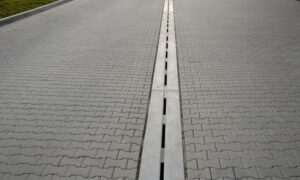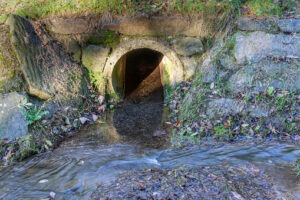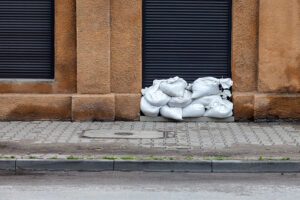The browser you are using is not supported. Please consider using a modern browser.

Water Storm Drains: Flood Prevention & Yard Drainage Solutions.

According to Water Damage Defense, around 14,000 people in the U.S. face water damage emergencies daily, and a whopping 98% of basements in the country will experience water damage at some point. By understanding and implementing a good drainage system to prevent flooding you can save your property from being damaged.
In this comprehensive article on water storm drains, we’ll explore various stormwater drainage systems and provide practical tips for flood prevention. We understand dealing with a flooded yard can be stressful – don’t worry. We have you covered with easy-to-follow steps to help you restore your yard and make it usable again.
We’ll also provide valuable information on how to mitigate flood risks. You’ll discover various types of drainage systems that are designed to handle stormwater effectively. Some of these prevention methods you can implement on your own to safeguard your backyard from flooding.
So, if you’re concerned about flooding or facing a flooded yard, don’t despair. We’re here to guide you through the process of prevention and restoration.
Understanding Water Storm Drains
Storm drain technology isn’t a new concept. In fact, ancient civilizations used drains to direct water flow. Managing stormwater has always been important to prevent flooding and damage to property. Knowing about storm water drainage systems will help protect your property, prevent damage, and guarantee public safety.
Storm drains collect rainwater from the house’s storm gutters on private property. Homeowners can direct this collected water to larger storm drainage systems throughout a city. Street gutters also collect rainwater and channel it to storm drains alongside streets below the sidewalk.
Storm drains operate by using gravity to collect and move rainwater. Water flows through the system and moves into larger pipes until the overflow directs to streams or rivers.
Storm Drain vs. Sewer Drain: Knowing the Difference
Storm drains are made to carry rainwater and other types of drainage. On the other hand, sewer drains carry sewage to special treatment plants, where it gets cleaned up and safely released. Knowing the difference is important because storm drains shouldn’t carry harmful waste or sewage.
The untreated rainwater carried by storm drains can end up in local streams, rivers, and other bodies of water. So, we must be careful about what goes into storm drains to keep our water clean and healthy.
The Importance of Drainage Systems in Flood Prevention
Having a proper drainage system is crucial for flood prevention. When it rains, we must direct water away from buildings and homes, as standing water can cause serious damage to a property’s foundation, walls, and electrical systems. Flooded yards and streets can also be dangerous to vehicles and pedestrians.
One of the primary functions of stormwater drainage systems is to prevent flooding by efficiently collecting and directing rainwater away from populated areas. A good drainage system does the following:
- Prevents erosion
- Minimizes soil saturation
- Maintains the integrity of buildings and infrastructure
Installing flood prevention systems protects your home from potential damage, especially with extreme summer weather on the horizon. For instance, you can use a water alarm to detect water levels and alert homeowners of possible flooding. We’ll cover more prevention methods later on.
Types of Storm Water Drainage Systems
Storm water drainage systems come in many different types to suit various needs. Some common ones include slot, open, and closed storm drains.
Understanding the different types of storm water drainage systems will help you decide which system is best for your needs. Let’s take a closer look at these systems and their features.
Slot Drains
Slot drains are long, narrow channels that collect water from surfaces such as sidewalks, parking lots, and loading docks. They are popular in commercial and industrial settings because they quickly remove large amounts of water. As a result, they help to prevent flooding and slip and fall accidents. They’re also easy to maintain and long-lasting.

Open Storm Drains
You’ll typically find open storm drains or ditches in rural or undeveloped areas. They collect and carry rainwater from low-lying areas into larger bodies of water like rivers or lakes.
Because open storm drains can be difficult to see, they can pose a safety hazard, causing injury if someone accidentally falls in.

Closed Storm Drains
In urban areas, you’ll usually find closed storm drains. They’re typically made up of a network of pipes and underground chambers that collect and transport water away from populated areas.
Closed storm drains are generally safer than open storm drains because they’re underground and not exposed. They must be checked regularly to prevent clogs and ensure they’re working correctly.

4 Ways to Prevent Flooding in and Around Your Home
In addition to storm water drains, you can use flood prevention methods to keep your home safe from water damage. The following flood prevention methods will keep your home protected and help you avoid damage caused by water.
1. Flood Prevention Barriers and Systems
You can prevent flooding around your home by using flood prevention barriers. By installing these barriers around your property, you can create a shield that prevents water from entering.
You can install many flood prevention systems, such as sump pumps and drainage tiles. These systems help prevent water from accumulating around your home and causing damage.
2. Learn How to Redirect Water Runoff
Another effective way to prevent flooding is by redirecting water runoff. For instance, you could install a channel drain for driveways, which collects water and directs it away from your home. This process reduces the risk of flooding and water damage.
3. Learn How to Sandbag a Doorway
Sandbag a doorway to keep water from entering your home in the event of heavy rain or flooding. You can place sandbags around a doorway to create a barrier that keeps water out. If you decide to sandbag a doorway, ensure you properly stack the sandbags so that they are effective.

4. Improve Yard Grade
If your yard is sloped toward your home, water can accumulate at the bottom of the slope around the foundation and cause damage. Add soil to create a gentle slope away from your home and direct water away from the foundation. Doing so will prevent further water damage.
DIY Backyard Flooding Solutions
If you’re concerned about flooding, there are measures you can take yourself to safeguard your backyard. Let’s delve into three practical steps to protect your home. Each topic is supplemented with recommended reading or viewing materials to prepare you for the projects.
1. Rain Garden
A rain garden is a beautiful and practical solution to prevent backyard flooding that you can install yourself. It involves creating a shallow depression in your yard and planting native plants good at absorbing water.
When it rains, the garden acts as a sponge, soaking up excess water and preventing it from pooling in your yard. It’s an eco-friendly way to manage water runoff and reduce the risk of flooding.
Recommended Reading: How to Build a Rain Garden
2. Install Channel Drain for Driveways
Channel drains are long, narrow drains placed at the edge of a driveway. They collect and direct water away, preventing water from flooding your driveway.
This project is more challenging to do yourself but can save you a good chunk of money when completed correctly. Installing a channel drain is perfect for a driveway accumulating water during heavy rainfalls.
Recommended video: How to Install NDS 5″ Trench Drain
3. French Drain Installation
A French drain is a trench filled with rock or gravel that contains a perforated pipe. Like other drainage solutions, it collects water and diverts it away from your yard or home’s foundation.
You can direct water to your desired location with a French drain, such as a drainage ditch or a storm drain. These drains are particularly useful in areas with poor soil drainage.
Recommended video: DIY French Drain
How to Drain a Flooded Yard
If your yard has flooded, it’s important to properly drain the water, fix any issues, and make your outdoor space usable again. The following steps will help you drain your yard:
1. Assess the Situation
How much water is in your yard? Where is the water coming from? Answering these questions will help you decide how to best drain your yard.
2. Remove Debris
Remove any trash blocking the water’s path – leaves, branches, or other objects stopping the water from flowing away.
3. Make a Drainage Path
Where is the lowest point in your yard? Dig a shallow trench or channel there that slopes away from the flooded area. Doing so will help the water find a way to flow from your yard.
4. Use a Pump
If the water isn’t going away on its own, you should use a pump that can remove the extra water. Many home improvement stores offer different types of pumps for rentals, such as submersible pumps or wet/dry vacuums. Just make sure to follow the directions and use them safely.
5. Direct Water to the Right Place
You want to ensure the water goes away from your home and other areas that could flood. Guide it toward storm drains, ditches, or other places where it won’t cause more problems.
6. Address Underlying Problems
After cleaning up your yard, look for any issues that caused the flooding. You’ll want to address these, so you don’t end up with a flooded yard again. Pay attention to yard grading, blocked gutters, or weak drainage systems.
High Mark Construction: Your Flood Restoration Experts
Are you dealing with unexpected flood damage? At High Mark Construction, we understand the importance of fast storm restoration to bring your home or business back to its pre-flood condition – our team is here to help.
Our skilled professionals are experts in flood repairs and are committed to providing excellent customer service. We strive to make the restoration process smooth for you from start to finish. Fully licensed in multiple Mid-Atlantic states, we can work directly with your insurance company to make the process seamless.
You don’t want to wait to repair your flood damage. Contact us today for a free inspection and experience the High Mark difference.